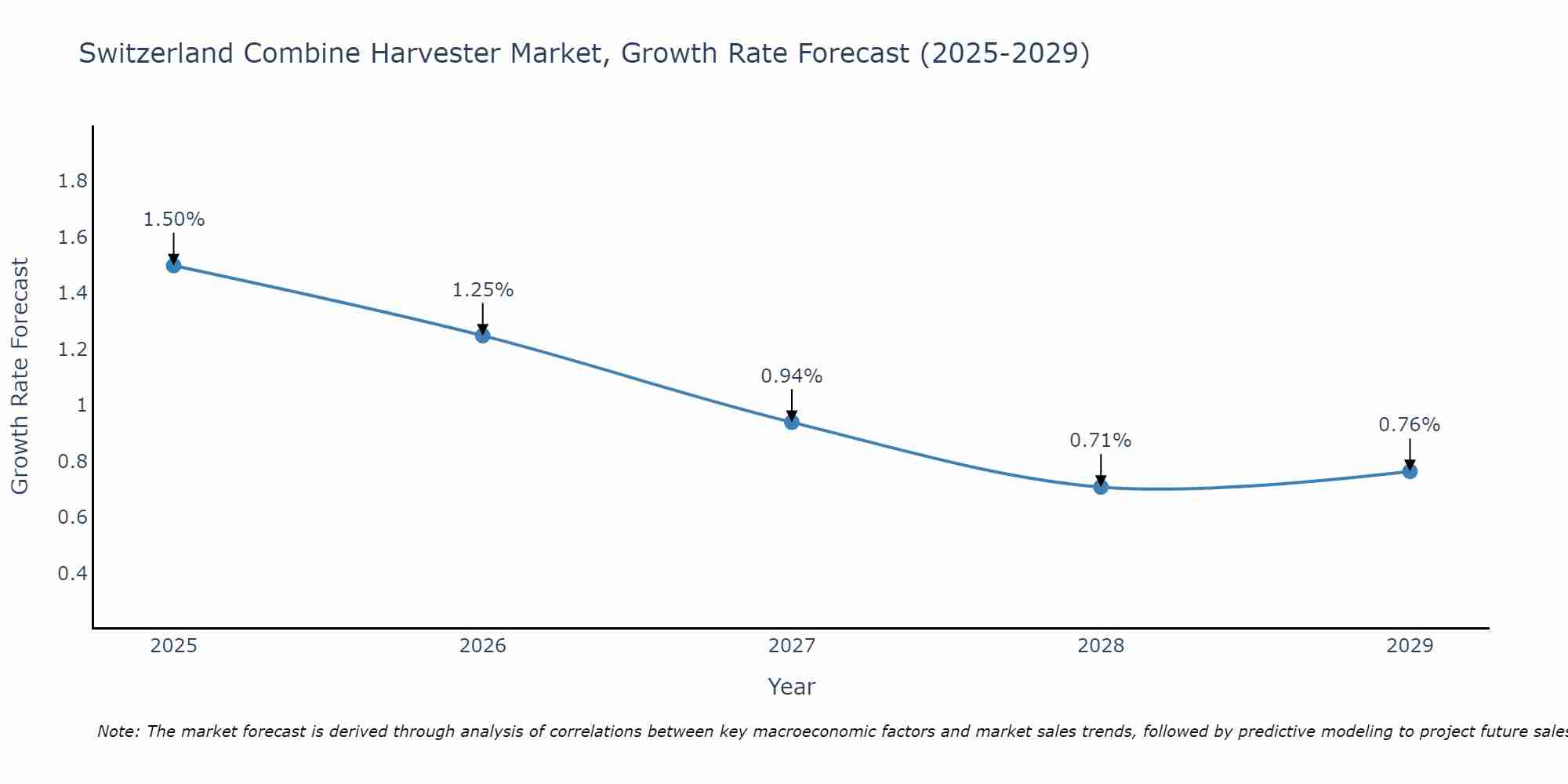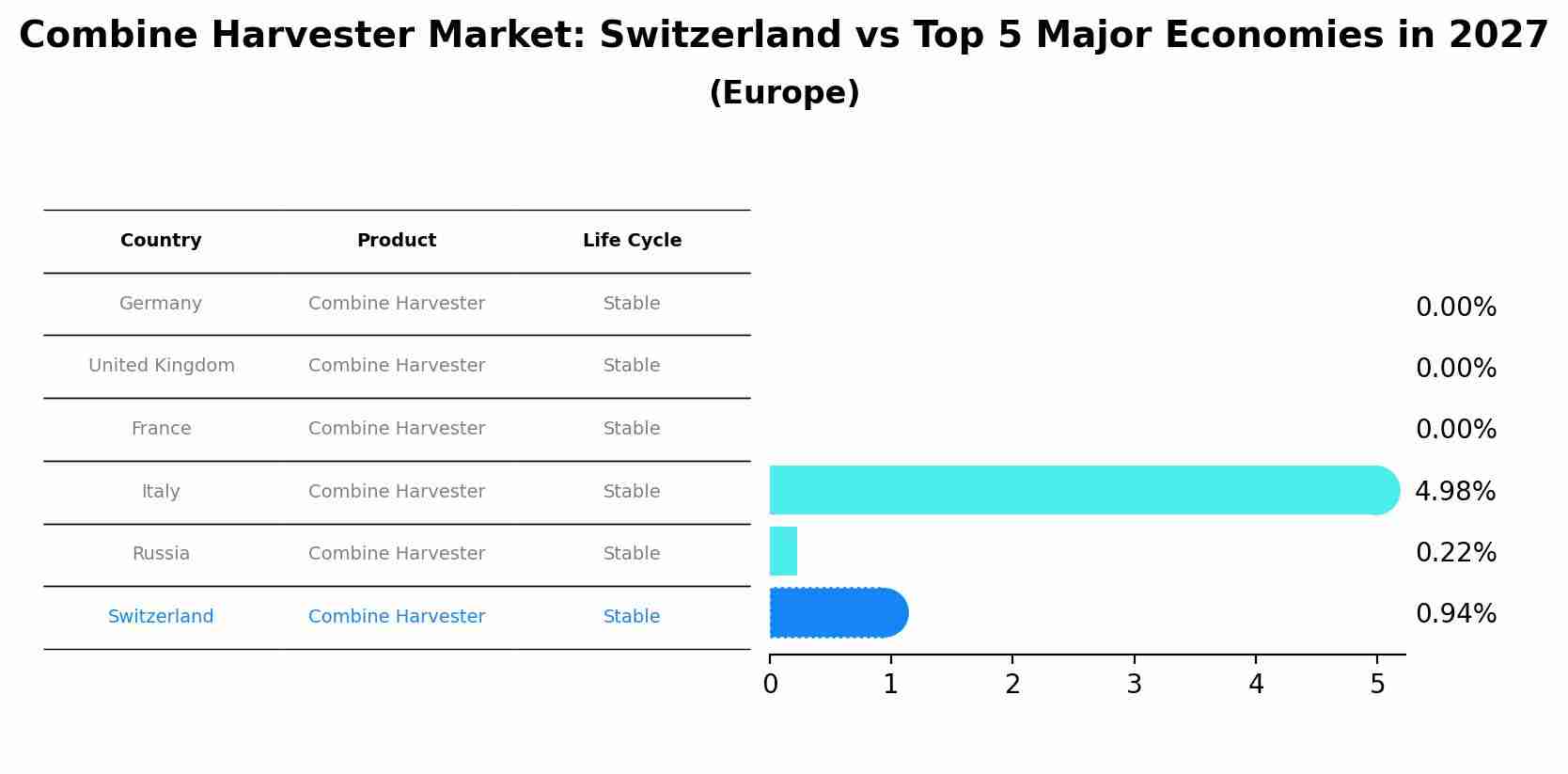Switzerland Combine Harvester Market (2025-2031) | Share, Size, Outlook, Segmentation, Trends, Revenue, Companies, Industry, Forecast, Growth, Value & Analysis
| Product Code: ETC5398313 | Publication Date: Nov 2023 | Updated Date: Aug 2025 | Product Type: Market Research Report | |
| Publisher: 6Wresearch | Author: Bhawna Singh | No. of Pages: 60 | No. of Figures: 30 | No. of Tables: 5 |
Switzerland Combine Harvester Market Size Growth Rate
The Switzerland Combine Harvester Market is projected to witness mixed growth rate patterns during 2025 to 2029. Although the growth rate starts strong at 1.50% in 2025, it steadily loses momentum, ending at 0.76% by 2029.

Combine Harvester Market: Switzerland vs Top 5 Major Economies in 2027 (Europe)
The Combine Harvester market in Switzerland is projected to grow at a stable growth rate of 0.94% by 2027, highlighting the country's increasing focus on advanced technologies within the Europe region, where Germany holds the dominant position, followed closely by United Kingdom, France, Italy and Russia, shaping overall regional demand.

Switzerland Combine Harvester Market Overview
The combine harvester market in Switzerland is a crucial part of the agricultural machinery sector, with a focus on improving efficiency in grain harvesting. Switzerland`s small-scale farming landscape requires highly efficient and versatile harvesters that can adapt to various terrains. The market is influenced by innovations in automation, precision farming, and sustainable agricultural practices, helping to reduce labor costs and increase productivity.
Drivers of the market
The combine harvester market in Switzerland is driven by the need for efficient agricultural practices to enhance crop yields and reduce labor costs. Switzerland`s focus on sustainable and technologically advanced farming methods encourages farmers to invest in modern machinery such as combine harvesters. Rising demand for food production and the push toward mechanized farming to improve productivity further support market growth. Additionally, government initiatives aimed at promoting the adoption of advanced agricultural equipment positively influence the combine harvester market.
Challenges of the market
The combine harvester market faces several challenges, including fluctuating agricultural commodity prices that impact farmers` purchasing power. Economic downturns can lead to reduced investments in new machinery, affecting sales for manufacturers. Moreover, the market is increasingly influenced by sustainability trends, requiring manufacturers to develop more efficient and environmentally friendly machines. Lastly, the integration of advanced technologies such as precision agriculture and automation demands continuous innovation and adaptation from producers.
Government Policy of the market
The combine harvester market in Switzerland is influenced by agricultural policies that promote sustainable farming practices. The Swiss Federal Office for Agriculture (FOAG) implements regulations that encourage the adoption of efficient machinery and technology in farming, providing subsidies for environmentally friendly equipment. There is also a focus on research and development initiatives aimed at improving agricultural productivity through innovative technologies. Additionally, policies related to land use and environmental protection affect the adoption of new machinery, ensuring that agricultural practices align with national sustainability goals.
Key Highlights of the Report:
- Switzerland Combine Harvester Market Outlook
- Market Size of Switzerland Combine Harvester Market, 2024
- Forecast of Switzerland Combine Harvester Market, 2031
- Historical Data and Forecast of Switzerland Combine Harvester Revenues & Volume for the Period 2021-2031
- Switzerland Combine Harvester Market Trend Evolution
- Switzerland Combine Harvester Market Drivers and Challenges
- Switzerland Combine Harvester Price Trends
- Switzerland Combine Harvester Porter`s Five Forces
- Switzerland Combine Harvester Industry Life Cycle
- Historical Data and Forecast of Switzerland Combine Harvester Market Revenues & Volume By Cutting Width for the Period 2021-2031
- Historical Data and Forecast of Switzerland Combine Harvester Market Revenues & Volume By Small Size Combine Harvester for the Period 2021-2031
- Historical Data and Forecast of Switzerland Combine Harvester Market Revenues & Volume By Large Size Combine Harvester for the Period 2021-2031
- Historical Data and Forecast of Switzerland Combine Harvester Market Revenues & Volume By Type for the Period 2021-2031
- Historical Data and Forecast of Switzerland Combine Harvester Market Revenues & Volume By Wheel Type Combine Harvester for the Period 2021-2031
- Historical Data and Forecast of Switzerland Combine Harvester Market Revenues & Volume By Crawler Type Combine Harvester for the Period 2021-2031
- Historical Data and Forecast of Switzerland Combine Harvester Market Revenues & Volume By Power Source for the Period 2021-2031
- Historical Data and Forecast of Switzerland Combine Harvester Market Revenues & Volume By Tractor Pulled/PTO Powered Combine Harvester for the Period 2021-2031
- Historical Data and Forecast of Switzerland Combine Harvester Market Revenues & Volume By Self-Propelled Combine Harvester for the Period 2021-2031
- Switzerland Combine Harvester Import Export Trade Statistics
- Market Opportunity Assessment By Cutting Width
- Market Opportunity Assessment By Type
- Market Opportunity Assessment By Power Source
- Switzerland Combine Harvester Top Companies Market Share
- Switzerland Combine Harvester Competitive Benchmarking By Technical and Operational Parameters
- Switzerland Combine Harvester Company Profiles
- Switzerland Combine Harvester Key Strategic Recommendations
Frequently Asked Questions About the Market Study (FAQs):
1 Executive Summary |
2 Introduction |
2.1 Key Highlights of the Report |
2.2 Report Description |
2.3 Market Scope & Segmentation |
2.4 Research Methodology |
2.5 Assumptions |
3 Switzerland Combine Harvester Market Overview |
3.1 Switzerland Country Macro Economic Indicators |
3.2 Switzerland Combine Harvester Market Revenues & Volume, 2021 & 2031F |
3.3 Switzerland Combine Harvester Market - Industry Life Cycle |
3.4 Switzerland Combine Harvester Market - Porter's Five Forces |
3.5 Switzerland Combine Harvester Market Revenues & Volume Share, By Cutting Width, 2021 & 2031F |
3.6 Switzerland Combine Harvester Market Revenues & Volume Share, By Type, 2021 & 2031F |
3.7 Switzerland Combine Harvester Market Revenues & Volume Share, By Power Source, 2021 & 2031F |
4 Switzerland Combine Harvester Market Dynamics |
4.1 Impact Analysis |
4.2 Market Drivers |
4.2.1 Technological advancements in combine harvester machinery |
4.2.2 Increasing demand for higher agricultural productivity |
4.2.3 Growing adoption of precision farming techniques |
4.2.4 Government support and subsidies for modern farming equipment |
4.3 Market Restraints |
4.3.1 High initial investment costs associated with purchasing combine harvesters |
4.3.2 Limited availability of skilled labor for operating advanced machinery |
4.3.3 Fluctuating prices of agricultural commodities affecting farmers' purchasing power |
5 Switzerland Combine Harvester Market Trends |
6 Switzerland Combine Harvester Market Segmentations |
6.1 Switzerland Combine Harvester Market, By Cutting Width |
6.1.1 Overview and Analysis |
6.1.2 Switzerland Combine Harvester Market Revenues & Volume, By Small Size Combine Harvester, 2021-2031F |
6.1.3 Switzerland Combine Harvester Market Revenues & Volume, By Large Size Combine Harvester, 2021-2031F |
6.2 Switzerland Combine Harvester Market, By Type |
6.2.1 Overview and Analysis |
6.2.2 Switzerland Combine Harvester Market Revenues & Volume, By Wheel Type Combine Harvester, 2021-2031F |
6.2.3 Switzerland Combine Harvester Market Revenues & Volume, By Crawler Type Combine Harvester, 2021-2031F |
6.3 Switzerland Combine Harvester Market, By Power Source |
6.3.1 Overview and Analysis |
6.3.2 Switzerland Combine Harvester Market Revenues & Volume, By Tractor Pulled/PTO Powered Combine Harvester, 2021-2031F |
6.3.3 Switzerland Combine Harvester Market Revenues & Volume, By Self-Propelled Combine Harvester, 2021-2031F |
7 Switzerland Combine Harvester Market Import-Export Trade Statistics |
7.1 Switzerland Combine Harvester Market Export to Major Countries |
7.2 Switzerland Combine Harvester Market Imports from Major Countries |
8 Switzerland Combine Harvester Market Key Performance Indicators |
8.1 Average utilization rate of combine harvesters in Switzerland |
8.2 Adoption rate of precision farming technologies in the country |
8.3 Percentage of farmers using financing options for purchasing modern agricultural equipment |
9 Switzerland Combine Harvester Market - Opportunity Assessment |
9.1 Switzerland Combine Harvester Market Opportunity Assessment, By Cutting Width, 2021 & 2031F |
9.2 Switzerland Combine Harvester Market Opportunity Assessment, By Type, 2021 & 2031F |
9.3 Switzerland Combine Harvester Market Opportunity Assessment, By Power Source, 2021 & 2031F |
10 Switzerland Combine Harvester Market - Competitive Landscape |
10.1 Switzerland Combine Harvester Market Revenue Share, By Companies, 2024 |
10.2 Switzerland Combine Harvester Market Competitive Benchmarking, By Operating and Technical Parameters |
11 Company Profiles |
12 Recommendations | 13 Disclaimer |
- Single User License$ 1,995
- Department License$ 2,400
- Site License$ 3,120
- Global License$ 3,795
Search
Related Reports
- ASEAN Bearings Market (2025-2031) | Strategy, Consumer Insights, Analysis, Investment Trends, Opportunities, Growth, Size, Share, Industry, Revenue, Segments, Value, Segmentation, Supply, Forecast, Restraints, Outlook, Competition, Drivers, Trends, Demand, Pricing Analysis, Competitive, Strategic Insights, Companies, Challenges
- Europe Flooring Market (2025-2031) | Outlook, Share, Industry, Trends, Forecast, Companies, Revenue, Size, Analysis, Growth & Value
- Saudi Arabia Manlift Market (2025-2031) | Outlook, Size, Growth, Trends, Companies, Industry, Revenue, Value, Share, Forecast & Analysis
- Uganda Excavator, Crane, and Wheel Loaders Market (2025-2031) | Strategy, Consumer Insights, Analysis, Investment Trends, Opportunities, Growth, Size, Share, Industry, Revenue, Segments, Value, Segmentation, Supply, Forecast, Restraints, Outlook, Competition, Drivers, Trends, Demand, Pricing Analysis, Competitive, Strategic Insights, Companies, Challenges
- Rwanda Excavator, Crane, and Wheel Loaders Market (2025-2031) | Strategy, Consumer Insights, Analysis, Investment Trends, Opportunities, Growth, Size, Share, Industry, Revenue, Segments, Value, Segmentation, Supply, Forecast, Restraints, Outlook, Competition, Drivers, Trends, Demand, Pricing Analysis, Competitive, Strategic Insights, Companies, Challenges
- Kenya Excavator, Crane, and Wheel Loaders Market (2025-2031) | Strategy, Consumer Insights, Analysis, Investment Trends, Opportunities, Growth, Size, Share, Industry, Revenue, Segments, Value, Segmentation, Supply, Forecast, Restraints, Outlook, Competition, Drivers, Trends, Demand, Pricing Analysis, Competitive, Strategic Insights, Companies, Challenges
- Angola Excavator, Crane, and Wheel Loaders Market (2025-2031) | Strategy, Consumer Insights, Analysis, Investment Trends, Opportunities, Growth, Size, Share, Industry, Revenue, Segments, Value, Segmentation, Supply, Forecast, Restraints, Outlook, Competition, Drivers, Trends, Demand, Pricing Analysis, Competitive, Strategic Insights, Companies, Challenges
- Israel Intelligent Transport System Market (2025-2031) | Strategy, Consumer Insights, Analysis, Investment Trends, Opportunities, Growth, Size, Share, Industry, Revenue, Segments, Value, Segmentation, Supply, Forecast, Restraints, Outlook, Competition, Drivers, Trends, Demand, Pricing Analysis, Competitive, Strategic Insights, Companies, Challenges
- Uganda Precast and Aggregate Market (2025-2031) | Strategy, Consumer Insights, Analysis, Investment Trends, Opportunities, Growth, Size, Share, Industry, Revenue, Segments, Value, Segmentation, Supply, Forecast, Restraints, Outlook, Competition, Drivers, Trends, Demand, Pricing Analysis, Competitive, Strategic Insights, Companies, Challenges
- Australia IT Asset Disposal Market (2025-2031) | Strategy, Consumer Insights, Analysis, Investment Trends, Opportunities, Growth, Size, Share, Industry, Revenue, Segments, Value, Segmentation, Supply, Forecast, Restraints, Outlook, Competition, Drivers, Trends, Demand, Pricing Analysis, Competitive, Strategic Insights, Companies, Challenges
Industry Events and Analyst Meet
Our Clients
Whitepaper
- Middle East & Africa Commercial Security Market Click here to view more.
- Middle East & Africa Fire Safety Systems & Equipment Market Click here to view more.
- GCC Drone Market Click here to view more.
- Middle East Lighting Fixture Market Click here to view more.
- GCC Physical & Perimeter Security Market Click here to view more.
6WResearch In News
- Doha a strategic location for EV manufacturing hub: IPA Qatar
- Demand for luxury TVs surging in the GCC, says Samsung
- Empowering Growth: The Thriving Journey of Bangladesh’s Cable Industry
- Demand for luxury TVs surging in the GCC, says Samsung
- Video call with a traditional healer? Once unthinkable, it’s now common in South Africa
- Intelligent Buildings To Smooth GCC’s Path To Net Zero













